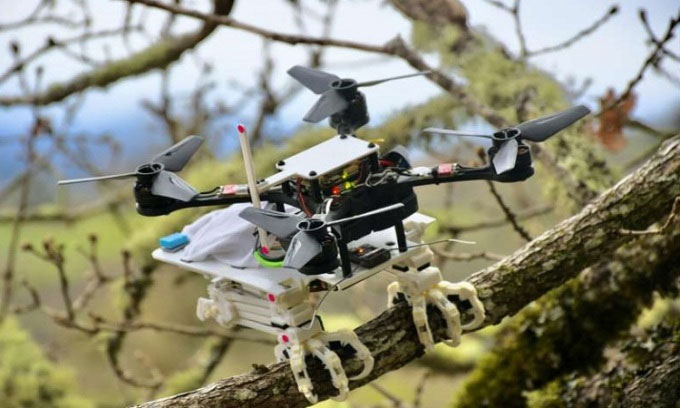Engineers Create a Falcon-Inspired Robot That Can Take Off, Land, and Grasp Objects Midair
Developed by a research team at Stanford University, SNAG (Nature-Inspired Aerial Grasping Device) mimics the impressive prey-catching behavior of large falcons. Instead of a skeleton, SNAG features a 3D-printed frame. The researchers created up to 20 versions to refine the device. They also utilized motors and fishing lines in place of muscles and tendons. Thanks to an attached quadcopter, SNAG can fly around to retrieve and carry objects as well as land on various surfaces.

SNAG robot created by the engineering team at Stanford University. (Photo: William Roderick).
Equipped with cameras and sensors, SNAG can be used to monitor climate, wildlife, and natural ecosystems, contributing to wildfire prevention and search and rescue missions. Recent testing in a forest in Oregon demonstrated that the device could take off and land from branches with the help of its 3D-printed claws.
Like real birds, SNAG can absorb impact forces when landing and convert them into gripping force to cling to branches. This similar mechanism also allows the robot to grasp objects like bean bags and tennis balls. The research team detailed the design in the journal Science Robotics on December 1.
“Simulating a bird’s flight and landing is not easy,” said lead researcher William Roderick from Stanford University. “After millions of years of evolution, they fly and land very simply, even on the most complex and diverse branches you can find in the forest. Like birds, SNAG has two legs that can move independently. This robot also has a sturdy frame and leg structure that serves as its skeleton.”
Birds can perch on any branch, regardless of whether the surface is rough, wet, covered in moss, or full of twigs. Creating a robot that mimics that behavior has become a major concern for Stanford engineers. They noted that SNAG was improved based on existing flying robot designs, which have limited capabilities in grasping real objects or landing after flight to conserve energy.
SNAG can land on various materials including wood, foam, sandpaper, and Teflon, similar to the parrotlet, the second smallest parrot species in the world. Each leg of SNAG is equipped with a motor for forward and backward movement and another motor for grasping objects, akin to the tendons in a bird’s leg.
After clinging to a branch, SNAG’s ankle locks tightly, and an accelerometer in its foot activates a balancing algorithm to stabilize the robot. According to Roderick, SNAG’s motors function like muscles and transmit force through the tendons. When the robot touches down, the accelerometer in its foot informs it of the impact and facilitates the balancing process.
Experiments with the robot design also allow Roderick and his colleagues to study how anatomical factors impact landing behavior. For example, they found no significant difference in landing ability between the two main toe shapes in birds. Future development of SNAG will focus on what happens before landing, such as improving the robot’s situational awareness and flight control.

















































